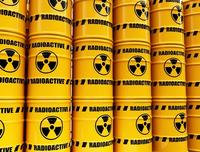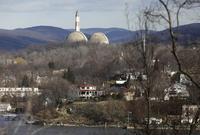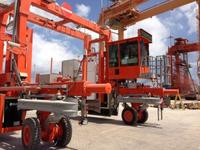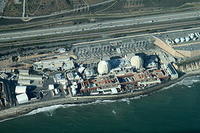-
Reducing volume of nuclear waste by 90 percent possible

Engineers have developed a way significantly to reduce the volume of some higher activity wastes, which will reduce the cost of interim storage and final disposal. The researchers have shown that mixing plutonium-contaminated waste with blast furnace slag and turning it into glass reduces its volume by 85-95 percent. It also effectively locks in the radioactive plutonium, creating a stable end product.
-
-
Where should U.S. radioactive waste be buried?
In the United States, about 70,000 metric tons of spent commercial nuclear fuel are located at more than seventy sites in thirty-five states. Shales and other clay-rich (argillaceous) rocks have never been seriously considered for holding America’s spent nuclear fuel, but it is different overseas. France, Switzerland, and Belgium are planning to put waste in tunnels mined out of shale formations, and Canada, Japan, and the United Kingdom are evaluating the idea.
-
-
Sharp increase in radioactive water leaks at Fukushima
Tokyo Electric Power(TEPCO) has reported a rise in groundwater radiation levels, saying a tank at the firm’s Fukushima plant leaked 300 metric tons of toxic water in August 2013. Water samples from wells, taken in mid-October, show a record-high concentration of beta-ray emitting substances, and a sharp increase in the presence of radioactive tritium. Japanese prime ministerShinzo Abe, in a tacit admission that Japan cannot effectively handle the continuing radiation leaks from the stricken plant, said Japan would be interested in receiving foreign help to contain widening radioactive water leaks at Fukushima.
-
-
Compound derived from vegetables offers shield from lethal radiation doses

Researchers say a compound derived from cruciferous vegetable such as cabbage, cauliflower, and broccoli protected rats and mice from lethal doses of radiation. The compound, known as DIM could protect normal tissues in patients receiving radiation therapy for cancer, but could also protect individuals from the lethal consequences of a nuclear disaster.
-
-
Arktis closes $2 million financing round
Zürich, Switzerland-based Arktis Radiation Detectors Ltd., developer of a proprietary fast neutron detection technology which offers an innovative detection method for discovering well-shielded nuclear materials, successfully closed a round of financing worth $2 million.
-
-
Children living close to nuclear power plants do not have higher risk of developing leukemia

Young children who live near nuclear power plants do not have a greater risk of developing childhood leukemia or non-Hodgkin Lymphoma according to new research. Researchers conducted a study of almost 10,000 children under five years of age who were diagnosed with leukemia or similar cancers in Britain between 1962 and 2007. The scientists measured the distance from the nearest nuclear power plant both at birth and when diagnosed with childhood leukemia or non-Hodgkin lymphoma, and found that there was no apparent extra risk living near a nuclear power plant.
-
-
Long-term radiation effects: Chernobyl’s lessons for Fukushima
The Fukushima Daiichi nuclear disaster spread significant radioactive contamination over more than 3,500 square miles of the Japanese mainland in the spring of 2011. Now several recently published studies of Chernobyl are bringing a new focus on just how extensive the long-term effects on Japanese wildlife might be.
-
-
U.S. nuclear reactors vulnerable to terrorist attack: study
More than ten years after the 9/11 hijackers considered flying a fully loaded passenger jet into a Manhattan area nuclear reactor, U.S. commercial and research nuclear facilities remain inadequately protected against two credible terrorist threats — the theft of bomb-grade material to make a nuclear weapon, and sabotage attacks intended to cause a reactor meltdown. A new report finds that none of the 104 commercial nuclear power reactors in the United States is adequately protected — but among the most vulnerable are eleven reactors in California, Connecticut, Florida, Maryland, Massachusetts, Missouri, New York, North Carolina, Texas, and Virginia. One of these reactors, on the grounds of the National Institute of Standards and Technology (NIST), is among the three research reactors fueled with bomb-grade uranium, and is located in the Washington, D.C. suburb of Gaithersburg, less than twenty-five miles from the White House.
-
-
U.S. radiation exposure guidelines based on unvalidated assumptions: toxicologist
In the 1950s regulators came to adopt the linear no threshold (LNT) dose-response approach to ionizing radiation exposure, which was later generalized to chemical carcinogen risk assessment. A UMass Amherst toxicologist now offers further evidence to support his earlier assertions that two geneticists deliberately suppressed evidence to prevent the U.S. National Academy of Sciences (NAS) from considering an alternative, threshold model, for which there was experimental support. “This isn’t an academic debate; it’s practical, because all of our rules about chemical and low-level radiation are based on unvalidated assumptions and scientific panel decisions made without sound evidence,” the toxicologist says.
-
-
Detecting radioactive material smuggled in containers

Nearly 90 percent of imported and exported goods travel the globe in shipping containers. Roughly 500 million containers travel the sea each year. A Sandia National Laboratories team completed acceptance testing on an enormous mobile scanner — the Mobile Radiation Detection and Identification System (MRDIS) — which makes smuggling radiological materials in containers more difficult.
-
-
Small modular reactors (SMEs) a “poor bet” to revive U.S. nuclear renaissance: report
A shift to small modular reactors (SMRs) is unlikely to breathe new life into the troubled U.S. nuclear power industry, since SMRs will likely require tens of billions of dollars in federal subsidies or government purchase orders, create new reliability vulnerabilities, as well as concerns in relation to both safety and proliferation, according a report issued last week.
-
-
Nuclear academics, professionals meet for 6th annual ATR NSUF Users Week
The sixth annual Advanced Test Reactor National Scientific User Facility (ATR NSUF) Users Week was held 10-14 June at University Place, the satellite campus for Idaho State University and University of Idaho in Idaho Falls. This nuclear research-themed week was the user facility’s opportunity to update the user community on nuclear energy issues and tools, conduct a research forum where users can come and present their research, run specialized workshops, and build collaboration among academic, industry and government institutions.
-
-
Specialized gas detection helps prevent nuclear weapons proliferation
Researchers aim to design a system capable of sensing, from among the loud signals of a lot of gases, the weak signals from specific gases which are signs of nuclear weapons proliferation. The researchers believe their gas correlation technique will prove ideal for a simple, inexpensive sensor to monitor those few illusive gases. This could change how the nation thinks about monitoring the spread of nuclear weapons. Instead of single-point measurements taken with expensive sensors deployed after someone suspects a problem, 24/7 continuous monitoring could find leaks early.
-
-
Highly portable X-ray imaging system developed
Los Alamos National Laboratory and Tribogenics have developed the MiniMAX (Miniature, Mobile, Agile, X-ray) camera to provide real-time inspection of sealed containers and facilities.MiniMAX is an alternative to the large, expensive, and fixed facilities presently required for security inspections using X-ray imaging. The complete MiniMAX portable radiography system weighs less than five pounds.
-
-
California’s San Onofre nuclear power plant retired due to safety concerns

Southern California Edison (SCE) has decided it will retire the San Onofre nuclear power plant located on the California coast. The decision comes after officials debated for over a year whether the twin reactors could be safely restarted. The power plant is located in a populated area, with millions living near it.
-
- All
- Regional
- Water
- Biometrics
- Borders/Immig
- Business
- Cybersecurity
- Detection
- Disasters
- Government
- Infrastructure
- International
- Public health
- Public Safety
- Communication interoperabillity
- Emergency services
- Emergency medical services
- Fire
- First response
- IEDs
- Law Enforcement
- Law Enforcement Technology
- Military technology
- Nonlethal weapons
- Nuclear weapons
- Personal protection equipment
- Police
- Notification /alert systems
- Situational awareness
- Weapons systems
- Sci-Tech
- Sector Reports
- Surveillance
- Transportation
Advertising & Marketing: advertise@newswirepubs.com
Editorial: editor@newswirepubs.com
General: info@newswirepubs.com
2010-2011 © News Wire Publications, LLC News Wire Publications, LLC
220 Old Country Road | Suite 200 | Mineola | New York | 11501
Permissions and Policies
Editorial: editor@newswirepubs.com
General: info@newswirepubs.com
2010-2011 © News Wire Publications, LLC News Wire Publications, LLC
220 Old Country Road | Suite 200 | Mineola | New York | 11501
Permissions and Policies
